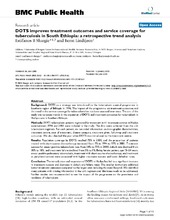| dc.description.abstract | Background: DOTS as a strategy was introduced to the tuberculosis control programme in Southern region of Ethiopia in 1996. The impact of the programme on treatment outcomes and the trend in the service coverage for tuberculosis has not been assessed ever since. The aim of the study was to assess trends in the expansion of DOTS and treatment outcomes for tuberculosis in Hadiya zone in Southern Ethiopia. Methods: 19,971 tuberculosis patients registered for treatment in 41 treatment centres in Hadiya zone between 1994 and 2001 were included in the study. The data were collected from the unit tuberculosis registers. For each patient, we recorded information on demographic characteristics, treatment centre, year of treatment, disease category, treatment given, follow-up and treatment outcomes. We also checked the year when DOTS was introduced to the treatment centre. Results: Population coverage by DOTS reached 75% in 2001, and the proportion of patients treated with short course chemotherapy increased from 7% in 1994 to 97% in 2001. Treatment success for smear-positive tuberculosis rose from 38% to 73% in 2000, default rate declined from 38% to 18%, and treatment failure declined from 5% to 1%. Being female patient, age 15–24 years, smear positive pulmonary tuberculosis, treatment with short course chemotherapy, and treatment at peripheral centres were associated with higher treatment success and lower defaulter rates. Conclusion: The introduction and expansion of DOTS in Hadiya has led to a significant increase in treatment success and decrease in default and failure rates. The smaller institutions exhibited better treatment outcomes compared to the larger ones including the zonal hospital. We identified many patients with missing information in the unit registers and this issue needs to be addressed. Further studies are recommended to see the impact of the programme on the prevalence and incidence of tuberculosis. | en_US |
